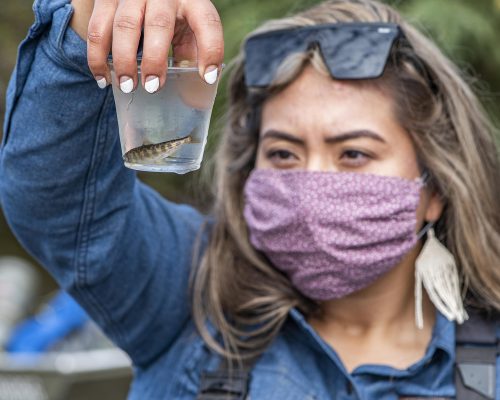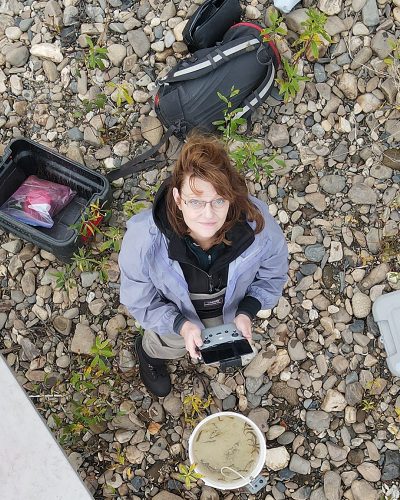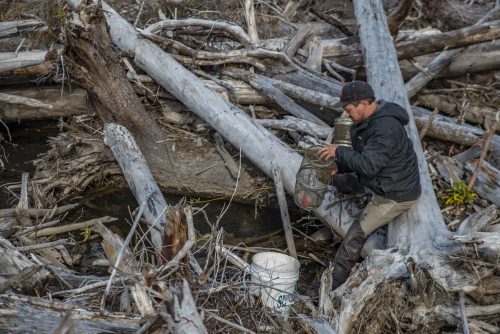Researchers evaluate wildfire impacts using unmanned aircraft
January 22, 2021
Tom Moran
907-474-5581

University of Alaska Fairbanks scientists are teaming up with Tanana Chiefs Conference for a pair of projects that use small unmanned aircraft systems to study impacts related to wildfires.
The collaboration between TCC — the regional nonprofit organization representing 42 Interior Alaska Native tribes — and UAF researchers is supported by the National Science Foundation. The Alaska NSF Established Program to Stimulate Competitive Research aims to gather information about vegetation regrowth in village firebreaks, and about how fires along rivers could influence salmon habitat and growth rates.
“I want us to co-produce research that helps TCC advocate for the interests of their communities and helps them make smart, timely and adaptive decisions with regard to wildfire and to resilience to wildfire,” said EPSCoR researcher Todd Brinkman, a UAF associate professor of wildlife ecology. “They’ve got a better handle on what’s important to their communities than we do.”
The firebreak research began in May 2020, when TCC Forester Fabian Keirn traveled to the communities of Dot Lake, Tanacross and Tetlin, all of which have had preventive firebreaks put in over the last 20 years. They are all “shaded fuel breaks,” in which crews thinned stretches of woods to facilitate fire suppression instead of clear-cutting.

Keirn gathered aerial photos of the firebreaks using a small unmanned aircraft. He ground-truthed the data by measuring the size and number of trees and the percent cover of grasses at a set of small circular plots along the firebreaks. He then shipped the data to UAF, where researchers will see how successfully it can be used to correctly classify vegetation types.
Keirn said the data could enable researchers to examine whether firebreaks have grown back to the point where they may no longer serve their purpose. They could also to look at how effective these types of fuel breaks have been.
“I don’t think too many people have done too many studies on these shaded fuel breaks,” he noted. “Whether or not that (strategy) is working hasn’t really been followed up on.”
Brinkman said the project is also a proof-of-concept of small unmanned aircraft systems, which could provide organizations with a rapid, simple tool for the time-consuming process of evaluating firebreaks.
Imagery collected by TCC also plays a major part in an EPSCoR project to study the impacts of forest fires on juvenile Chinook salmon in the upper Chena River outside Fairbanks. A team led by Erik Schoen, a research scientist with the UAF Institute of Arctic Biology, spent summer 2020 measuring fish, aquatic invertebrates and water quality in the Chena and its tributaries. They wanted to see whether portions of the river upstream and downstream of recent fire sites exhibit different characteristics that could affect juvenile salmon.
Fires may affect juvenile salmon by flushing more sediment into the water and increasing river turbidity, which may inhibit feeding and growth. To study turbidity, TCC Natural Cultural Resources Specialist Debra Lynne used an sUAS to gather imagery of the Chena River where sampling was taking place. The multispectral imagery then went to TCC Fisheries Biologist Brian McKenna to create maps displaying the Normalized Difference Water Index — an optical measure that prior studies have used to estimate turbidity. McKenna will compare the imagery to direct river measurements to see how well NDWI can track turbidity.

As with the firebreak project, McKenna and Schoen said, a major goal of the research is to test the effectiveness of the sUAS as a rapid deployment tool, especially in remote environments.
The EPSCoR research is part of Fire & Ice, a five-year project to study climate-driven changes to boreal wildfire regimes and to ecosystems and marine life in the nearshore Gulf of Alaska. McKenna said the work is a good fit with TCC’s research interests.
“Chinook salmon are an important source of food for the residents of the TCC region within the Yukon and Kuskokwim rivers, and also provide an important cultural role in fish camps,” he said. “We were excited about the projects because we want to better understand how climate change is impacting wild food resources, so we can better manage these resources.”


